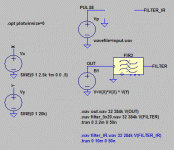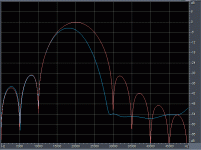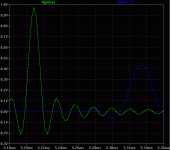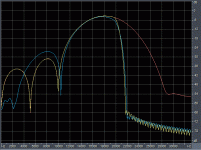You are arguing against a mathematical identity equation.
I really think you should find a math professor and argue with him/her.
I am not the one who created that trig identity.
Truly unbelievable. Now we are all sent back to primary school to confirm JN's view of reality.
What's left here? Probably debating if the 15+4+5=17+7 identity means that adding a 15KHz, a 4KHz and a 5KHz produces a 17KHz and a 7KHz. Or perhaps a 10KHz and a 14KHz? Or...
Don't you feel at least a little bit embarrased?
I assume you did not see my edits, I really hate the IPad.
Look up the trig identity sin(a)+ sin(b), plug in 17.5 for a and 22.5 for b.
Jn
In this context are the 17.5 and 22.5 radians or degrees?
The use of continuous sines and large windows guarantees the results he is showing.
That will not be what happens with short bursts. Just go back and look at my PSP analysis. Han's started with 20khz, ended up with 17.5 kHz.
Throwing up simulations which are entirely different is strawmanish.
Jn
I do not understand the dug in refusal to deal with this. It is most important points.
THx-RNMarsh
I do not understand the dug in refusal to deal with this.
Don’t wear your precious cortex with such insignificant problems, Nepal needs you.
Last edited:
Don’t wear your precious cortex with such insignificant problems, Nepal needs you.
so clever. Cute.
🙄
These short dense transient bursts at high freqs tend towards being discontinuities.
Waly, please stay away from sensitive gentle peoples of Nepal with your poison. The gentle Gurkha men will have your head with their Kukri.
😱
-Richard
Last edited:
These short dense transient bursts at high freqs tend towards being discontinuities.
Yeah, tell me more about these short dense transient bursts and how they tend to be discontinuities, I find them so fascinating and exciting!
Last edited:
Why not? You are proving that's the case. 🙂Really, you're going with that?
I detail exactly how a modulated sine and a pair of sines added are identical mathematically, detailed exactly what Han's waveforms were showing, and your going with "time domain viewing can be misleading"?
Really?
Jn
JN -- The whole beats / addition / modulation thing was pretty well covered in the Wiki "beats" page posted a page or three back??
Also - as it's kind of your thing at the moment, why don't you re-sim Hans' data instead of keep asking someone else to do it? I'm not trying to be snarky, just saying it would be the quick and easy way to make your point? Genuine attempt to be helpful... 🙂
I think plenty of free software that can do it has been referred to?
Also - as it's kind of your thing at the moment, why don't you re-sim Hans' data instead of keep asking someone else to do it? I'm not trying to be snarky, just saying it would be the quick and easy way to make your point? Genuine attempt to be helpful... 🙂
I think plenty of free software that can do it has been referred to?
The bests you can find.With what real world microphone and recording equipment to capture these rise-times?
As many mikes are able to go more or less up to 40kHz (no brick wall, here) it seems reasonable to set our sampling frequency to 96kHz.
As 24 bits seems enough to lead to no critic for overall and micro dynamic, why not to use-it ?
That is easy, available, not anymore expensive.
Now, for your own use, you are free to choose your poison, down to MP3.
End of controversy ? It looks like it is not a subject, just a pretext to fight, which seems the favorite game of some contributors in this kindergarten.
What reason would we have to protest against cars capable of driving faster than speed limits?
Rather protest against the latter when they are stupid, don't you think ?
Last edited:
Horns reproduce percussion with better subjective dynamics than usual membrane speakers. Especially those awful soft dome tweeters.
All those who use horns will confirm you. However, they often cut lower in frequency.
What makes the difference ? Damping (waterfall) ? Are transients less correlated with slew rate than we can imagine ?
Adding my big 46" sub (30Hz) in my system increase the subjective impact of kick drums. Explanation ?
All those who use horns will confirm you. However, they often cut lower in frequency.
What makes the difference ? Damping (waterfall) ? Are transients less correlated with slew rate than we can imagine ?
Adding my big 46" sub (30Hz) in my system increase the subjective impact of kick drums. Explanation ?
Interesting question.In this context are the 17.5 and 22.5 radians or degrees?
Frequency.
You think the relationship does not hold if I substitute radians for degrees or omega t? The Clark site does say it is 2 pi circular, so they are inferring radians.
Jn
Why not? You are proving that's the case. 🙂
Ah, I see what you mean, you are correct.
For steady state, the technique used to create the wave will not be distinguishable.
For the sine burst however, it is very revealing.
Chris719:
The mic JC provided information on would be perfect. However, for most sources, the excess BW serves no useful purpose. I would use it only where transients containing hf content were being produced.
Jn
Last edited:
JN -- The whole beats / addition / modulation thing was pretty well covered in the Wiki "beats" page posted a page or three back??
Also - as it's kind of your thing at the moment, why don't you re-sim Hans' data instead of keep asking someone else to do it? I'm not trying to be snarky, just saying it would be the quick and easy way to make your point? Genuine attempt to be helpful... 🙂
I think plenty of free software that can do it has been referred to?
I have seen some here model and present data here in ways to attempt to support their arguments. Massaging the inputs, the time base, the parameters so as to obscure. For example, showing steady state results in lieu of the specific case being discussed.
Since it is my argument, my presenting data is not as strong as someone else providing it. I can see others examining my data with prejudice, and I could not blame them. Also, I cannot imagine how to do it using an IPad.
Is this specific example so difficult that only Han's was able to do it?
Given his description of the input signal, and the mathematical identity equation, is anybody still surprised that the filtered output is at 17.5 kHz despite the fact he used 20 khz going in?
Jn
Last edited:
The bests you can find.
As many mikes are able to go more or less up to 40kHz (no brick wall, here) it seems reasonable to set our sampling frequency to 96kHz.
As 24 bits seems enough to lead to no critic for overall and micro dynamic, why not to use-it ?
That is easy, available, not anymore expensive.
And yet the old tubed Neumann mikes are still loved and insisted on?
No one as far as I can tell has said that you shouldn't record at the highest bit depth and speed that you can in the studio. There are good reasons for this. The point is that redbook rates are more than adequate for domestic replay and there is nothing more than conjecture over if this statement can be disproved. I don't think also that anyone has said that well heeled pensioners should not pay over the odds for hi-rez downloads from scraggy old master tapes if they want to. It's their trying to force it down our throats that we don't like.
I most certainly can understand.I do not understand the dug in refusal to deal with this. It is most important points.
THx-RNMarsh
What is being said is completely outside what is being taught nowadays.
Prior to this discussion, I would have also fought the concept of a modulated sine using a carrier at 20 khz ever come out of a filter at a different frequency. Han's results, as I said, were absolutely unexpected to me. I expected envelope change, not frequency change. It took me a while, some digging, and discussion here for me to figure it out. Given a really good fit to the results using a mathematical identity equation is also a strong indicator as well. If anyone can prove that identity formula does not apply, I'm all ears.
I see so many engineers in interviews not understanding some basics, especially if outside their area of focus. Motion control engineers not even knowing what a Bode plot is, so cannot even discuss phase margin of a negative feedback loop in a PID...the gripe list is huge. I see the problem as one of being so specialized as to narrow the field of understanding.
A graduating engineer should have at least been introduced to the concepts, even if they cannot remember specifics.
Me, my advantage is the people resources in close proximity, both at work and on the web.
Jn
Last edited:
OK, here we go.Here you are, all you could possibly need.
Dropbox - LTSpice filter - Simplify your life
Just as a general remark and not meant for you:
Knowing that a signal with massive sidebands will change after having filtered everything above a certain frequency, it's rather naïve to be surprised when seeing that the time domain signal has changed.
Succes with these files, giving a first indication with suboptimal results for this purpose as you mentioned.
I will probably have to invest in Adobe Audition for more accurate results, but first I'll await your findings.
Hans
Summary:
- The FIR from the filter toolbox is basically fine while not high precision, and with Hans's parameters it doesn't do any brickwalling, rather a soft-knee shallow-slope response -- "gaussian pulse shaping" the docs say for the "FIR2" type, and the compromised performance is noted as well.
- the brickwalling is actually done by LTspice during output file saving, probably a crude resampling and that is what corrupts the signal spectrum. With precision brickwalling and resampling via Audition all is fine.
==> in the end, the FIR filter actually wasn't even responsible for what we have meant to test, it just puts a confusing additional overall shaping on the FR! LTspice's low-quality (re-)sampling during file save was mainly responsible for the odd spectrum "distortion" that had confused some here ;-).
A proper brickwalling/resampling has no distortion and frequency shift etc effects on the time-domain and FR when out-of-band signals are cut off.
1) I had to change the .asc slightly to run correctly on my LTspice IV, see attachment:
- cosine generator is now made by squaring a half-period of a sine at half frequency.
- filter output is captured at 384kHz instead of the simple 44.1 resampling LTspice would perform.
Running this, I can basically confirm your 5x20 results:
- time domain plot looks same, note the discrete steps in the filter output, though. Time offset come from processing delay (expected).
- spectrum as analyzed by Audition looks the same (except the missing 44.1 brickwalling), a slowly increasing drop of magnitude at high frequencies.
2) To confirm this filter function, I tried to extract its impulse response (that's what the second half of the spice deck does when toggled to). It turned out that generation a sharp pulse with 1 sample width @384k inside LTspice upsets the FIR, therefore I made a band-limited dirac pulse, bandlimited to 96k and used that as the input signal. Again we have:
- time domain, showing the very short/low ringing of the output... they mention "gaussian pulse shaping" in the doc and that's what we see.
- the magnitude response (spectrum) confirms a soft-knee shallow slope, very "non-brickwally".
3) So what does LTspice's resampling to 44.1 for the output file do for brickwalling?
See comparison of original filter output @384k (red), a precision resampling to 44.1k and back with Audition(yellow), and the 44.1k LTspice output upsampled to 384k with Audition (blue). LTspice corrupts the output quite a bit. It has additional droop below 20k and the spectrum looks deformed overall (notches don't match, etc).
Attachments
Last edited:
- Status
- Not open for further replies.
- Home
- Member Areas
- The Lounge
- John Curl's Blowtorch preamplifier part III







